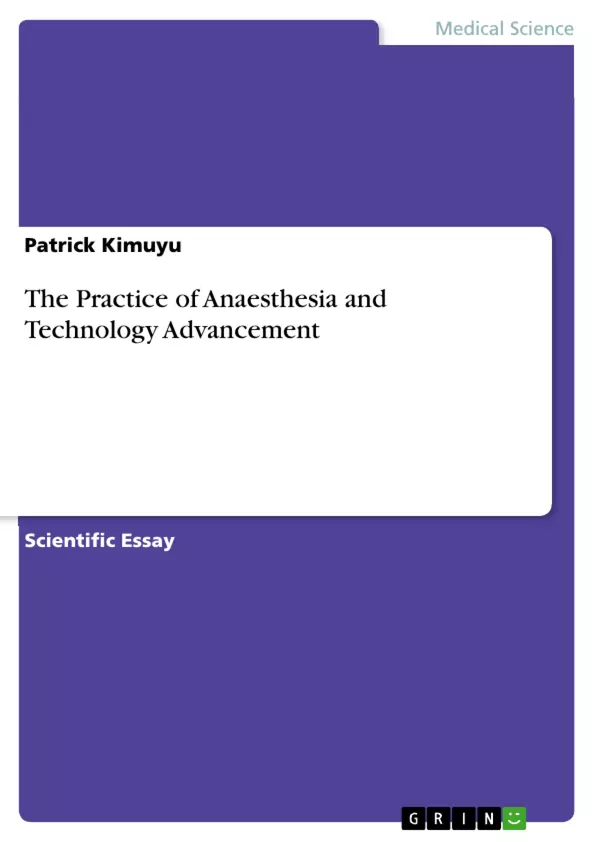This essay will discuss the newly invented technologies in anesthesia.
Technological advancement appears to have influenced all aspects of life in the universe leading to remarkable changes in the society. Currently, the world is flooded with new technologies and scientific discoveries and, more are still emerging. This implies that these new technologies and scientific inventions will exert an immense impact on society.
However, the wave of technological advancements seems to favor some fields with others experiencing the shock of technology impact. Interestingly, the field of healthcare and medicine are some of the beneficiaries of the newly emerging technologies; hence, medical practice has become relatively sophisticated owing to advanced delivery of care, treatment of chronic diseases and identification of newly emerging diseases and health conditions. It is worth noting that healthcare systems and the scope of medical sciences of the 21st Century are relatively different from the 19th Century versions because the impact of technological developments in the last decade seems to have transformed healthcare delivery systems with some of the newly invented technologies producing extraordinary performances.
However, it is worth noting that technological advancement in healthcare and medicine has not only led to the discovery of new drugs but, it has also improved safety and precision in clinical investigations. Moreover, it has led to the emergence of new medical procedures, which have, in turn, improved the quality of care offered to patients by healthcare professionals. For instance, the practice of anesthesia, which is seemingly built on technological advances, appear to have achieved a remarkable progress, especially with regard to the quality of care, owing to a number of technologies developed in the past decade.
Inhaltsverzeichnis (Table of Contents)
- Technological Advancement in Anesthesia
- The Bispectral Index (BIS) Monitor
- BIS Monitor and the Depth of Anesthesia
- BIS Monitor and Non-Surgical Stimulation
- BIS Monitor and Intensive Care
- McSleepy: A Fully-Automated Anesthesia Robot
- Endoscopic Ultrasound-Guided Fine Needle Aspiration (EUS-FNA)
Zielsetzung und Themenschwerpunkte (Objectives and Key Themes)
This essay explores the impact of technological advancements on the practice of anesthesia, specifically focusing on three key inventions: the Bispectral Index (BIS) monitor, the McSleepy automated anesthesia robot, and Endoscopic Ultrasound-Guided Fine Needle Aspiration (EUS-FNA). It examines the benefits and implications of these technologies on patient care, surgical outcomes, and the efficiency of anesthetic practices.
- The role of technological advancements in modern anesthesia practice.
- The impact of specific technologies on patient safety, monitoring, and surgical outcomes.
- The benefits and limitations of automated systems in anesthesia administration.
- The implications of technology for the evolving role of anesthesiologists.
- The potential for further advancements in technology to enhance anesthesia practice.
Zusammenfassung der Kapitel (Chapter Summaries)
- Technological Advancement in Anesthesia: This chapter introduces the topic of technological advancements in anesthesia and outlines the significant impact of new technologies on patient care, surgical procedures, and the overall practice of anesthesia.
- The Bispectral Index (BIS) Monitor: This chapter examines the BIS monitor, its functionality, and its contribution to improving the depth of anesthesia monitoring. It explores the benefits of the BIS monitor in various clinical settings and its role in guiding anesthetic agent administration.
- McSleepy: A Fully-Automated Anesthesia Robot: This chapter focuses on the McSleepy automated anesthesia robot, highlighting its capabilities and potential impact on anesthesia practice. It discusses the system's ability to monitor patient parameters, administer anesthesia, and adapt its behavior based on real-time data.
Schlüsselwörter (Keywords)
The primary focus of this essay is on the advancement of technology in the field of anesthesia, particularly in relation to the Bispectral Index (BIS) monitor, the McSleepy automated anesthesia robot, and Endoscopic Ultrasound-Guided Fine Needle Aspiration (EUS-FNA). Key themes include patient monitoring, anesthesia administration, surgical outcomes, and the evolving role of anesthesiologists in a technologically advanced healthcare landscape.
- Quote paper
- Patrick Kimuyu (Author), 2017, The Practice of Anaesthesia and Technology Advancement, Munich, GRIN Verlag, https://www.hausarbeiten.de/document/381141


